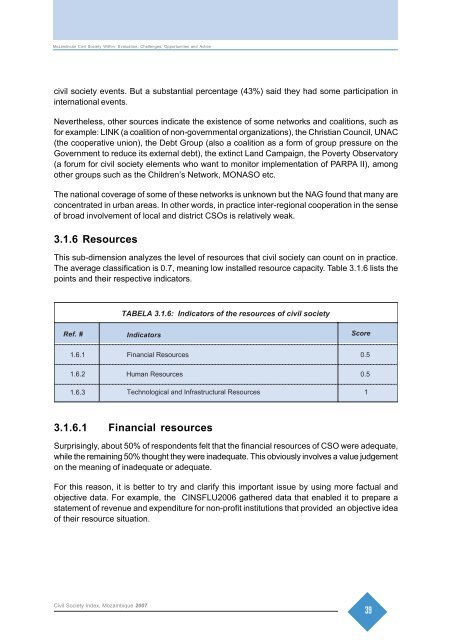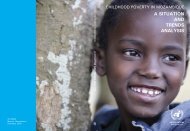Mozambican Civil Society Within: - UNICEF Mozambique - Home page
Mozambican Civil Society Within: - UNICEF Mozambique - Home page
Mozambican Civil Society Within: - UNICEF Mozambique - Home page
You also want an ePaper? Increase the reach of your titles
YUMPU automatically turns print PDFs into web optimized ePapers that Google loves.
<strong>Mozambican</strong> <strong>Civil</strong> <strong>Society</strong> <strong>Within</strong>: Evaluation, Challenges, Opportunities and Action<br />
civil society events. But a substantial percentage (43%) said they had some participation in<br />
international events.<br />
Nevertheless, other sources indicate the existence of some networks and coalitions, such as<br />
for example: LINK (a coalition of non-governmental organizations), the Christian Council, UNAC<br />
(the cooperative union), the Debt Group (also a coalition as a form of group pressure on the<br />
Government to reduce its external debt), the extinct Land Campaign, the Poverty Observatory<br />
(a forum for civil society elements who want to monitor implementation of PARPA II), among<br />
other groups such as the Children’s Network, MONASO etc.<br />
The national coverage of some of these networks is unknown but the NAG found that many are<br />
concentrated in urban areas. In other words, in practice inter-regional cooperation in the sense<br />
of broad involvement of local and district CSOs is relatively weak.<br />
3.1.6 Resources<br />
This sub-dimension analyzes the level of resources that civil society can count on in practice.<br />
The average classification is 0.7, meaning low installed resource capacity. Table 3.1.6 lists the<br />
points and their respective indicators.<br />
TABELA 3.1.6: Indicators of the resources of civil society<br />
Ref. # Indicators Score<br />
1.6.1 Financial Resources 0.5<br />
1.6.2 Human Resources 0.5<br />
1.6.3 Technological and Infrastructural Resources 1<br />
3.1.6.1 Financial resources<br />
Surprisingly, about 50% of respondents felt that the financial resources of CSO were adequate,<br />
while the remaining 50% thought they were inadequate. This obviously involves a value judgement<br />
on the meaning of inadequate or adequate.<br />
For this reason, it is better to try and clarify this important issue by using more factual and<br />
objective data. For example, the CINSFLU2006 gathered data that enabled it to prepare a<br />
statement of revenue and expenditure for non-profit institutions that provided an objective idea<br />
of their resource situation.<br />
<strong>Civil</strong> <strong>Society</strong> Index, <strong>Mozambique</strong> 2007<br />
39
















